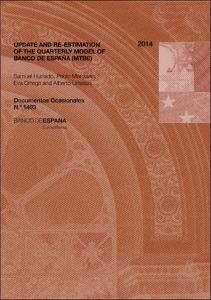Update and re-estimation of the Quarterly Model of Banco de España (MTBE)
Authors
Issue Date
19-Aug-2014
Physical description
27 p. : gráf., tab.
Abstract
El Modelo Trimestral del Banco de España (MTBE) es un modelo macroeconométrico de gran escala, utilizado para realizar previsiones macroeconómicas a medio plazo de la economía española, así como para evaluar las proyecciones realizadas por los expertos del Banco de España y simular escenarios alternativos. El modelo está especificado como un conjunto amplio de ecuaciones con mecanismo de corrección del error y, especialmente a corto plazo, está determinado principalmente por la demanda. Este documento presenta una actualización del modelo, estimada con datos de 1995-2012. En esta nueva versión, la inversión productiva privada y el empleo reaccionan más al output, capturando la mayor sensibilidad de estas variables observada durante la crisis, y los precios y salarios reaccionan menos tanto entre ellos como a la evolución de variables reales. El crédito es ahora una variable endógena del modelo y, además, ayuda a explicar el comportamiento de los principales componentes de la demanda. Como resultado de todo esto, las simulaciones del modelo ahora presentan, en términos generales, un canal de demanda más potente y unos efectos nominales menores y menos inerciales. El modelo actualizado describe una economía más reactiva ante perturbaciones financieras distintas de los tipos de interés, en la que la moderación salarial puede generar crecimiento y empleo si viene acompañada de moderación de precios, y en la que la consolidación fiscal reduce el déficit y tiene efectos negativos pero moderados sobre el PIB
The Quarterly Model of Banco de España (MTBE, Modelo Trimestral del Banco de España) is a large-scale macro-econometric model used for medium term macroeconomic forecasting of the Spanish economy, as well as for evaluating the staff projections and performing scenario simulations. The model is specified as a large set of error correction mechanism equations, and, especially in the short run, is mostly demand driven. This paper presents an update of the model, estimated with data from 1995-2012. In this new version, private productive investment and employment react more to output, capturing the higher sensitivity of these variables observed during the crisis, and prices and wages react less both to each other and to the evolution of real variables. Credit is now an endogenous variable in the model and it also helps explain the behaviour of the main demand components. As a result of all these changes, simulations now generally display a somewhat stronger demand channel and show nominal effects that are both smaller and with less inertia. The updated model describes an economy that is more reactive to financial shocks other than changes in interest rates, where wage moderation can generate growth and employment if it is followed by price moderation and where fiscal consolidation reduces public deficit and has negative but moderate effects on GDP
The Quarterly Model of Banco de España (MTBE, Modelo Trimestral del Banco de España) is a large-scale macro-econometric model used for medium term macroeconomic forecasting of the Spanish economy, as well as for evaluating the staff projections and performing scenario simulations. The model is specified as a large set of error correction mechanism equations, and, especially in the short run, is mostly demand driven. This paper presents an update of the model, estimated with data from 1995-2012. In this new version, private productive investment and employment react more to output, capturing the higher sensitivity of these variables observed during the crisis, and prices and wages react less both to each other and to the evolution of real variables. Credit is now an endogenous variable in the model and it also helps explain the behaviour of the main demand components. As a result of all these changes, simulations now generally display a somewhat stronger demand channel and show nominal effects that are both smaller and with less inertia. The updated model describes an economy that is more reactive to financial shocks other than changes in interest rates, where wage moderation can generate growth and employment if it is followed by price moderation and where fiscal consolidation reduces public deficit and has negative but moderate effects on GDP
Notes
Incluye bibliografía
Publish on
Documentos Ocasionales / Banco de España, 1403
Subjects
Economía española; Modelo macroeconométrico; Spanish economy; Macroeconometric model; Modelos econométricos; España
Appears in Collections:












